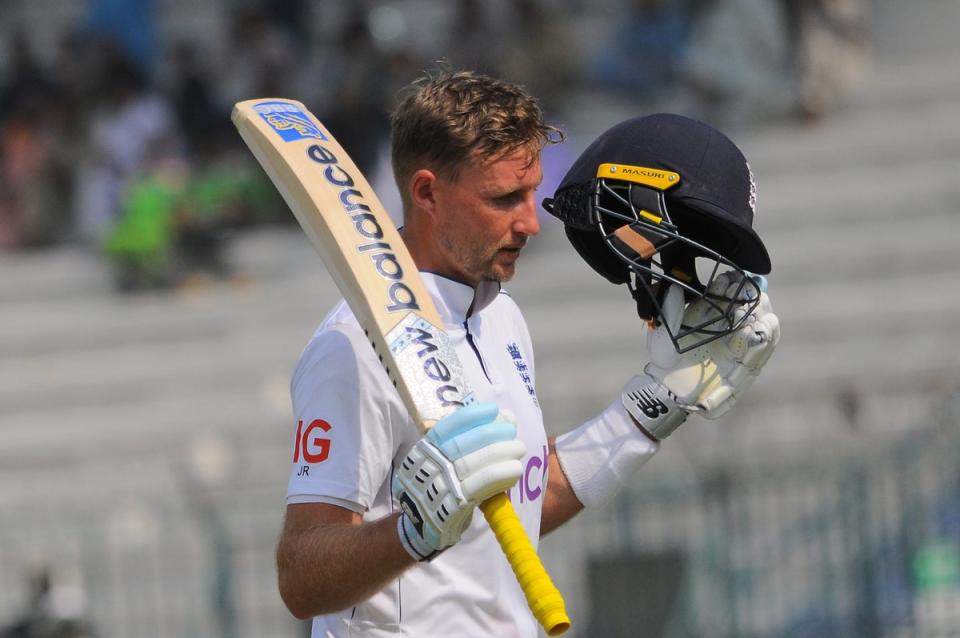Harry Brook and England’s heroics in Pakistan mask Test cricket’s lingering problem

Harry Brook struck a masterful triple century to catapult England into a position where winning the match against Pakistan has gone from near-impossible to almost within reach.
England scored 823 in their first innings, with Joe Root reaching his highest total in Test cricket as “Bazball” reached new heights. All this on a pitch that offered next to nothing for the bowlers in the searing heat of Multan.
Pakistan slumped to 59 for five before finishing the day batting to save the Test on 152 for six, still 115 runs behind. It should have been a fairly straightforward task to bat out the final four sessions on a pitch where batters had dominated from the outset, but for a side in turmoil and off the back of a series defeat to Bangladesh, the hosts did what they have had a tendency to do in the past: collapse.
Brook and Root made history with a partnership of 454, breaking the record for the highest partnership between two Englishmen set by Peter May and Colin Cowdrey against the West Indies in 1957. England’s total was their highest since the Second World War, and the fourth highest in Test cricket.
On day three, Root overtook Sir Alastair Cook to become England’s leading run-scorer in the format, and he added to that with a career-best 262, going past 20,000 runs in all forms of cricket for the national side in the process.
The pitch was flat. England scored runs with an ease not seen since they last visited Pakistan two years ago and memorably scored more than 500 on the opening day of that series at Rawalpindi.
The heat in Multan was oppressive and there was little movement or spin on offer for the tiring Pakistan attack, while England went on the offensive.
England’s aggressive approach with the bat allowed the possibility of a result. Their 823 for seven declared came in exactly 150 overs at a rate of 5.49 runs an over; no other side scores as quickly as the one led by Brendon McCullum and Ben Stokes. It has bought time in the game, and the potential to carve out another unlikely victory in Pakistan. No other national team would have been able to do so.
In Australia’s last Test against New Zealand for example, they scored their runs at 3.76 and 4.32 an over, while Sri Lanka put on 602 against the Kiwis at 3.68 runs an over, a far cry from England’s feat in Multan.
Also, the current England team do not give up; many others would have struggled after the hosts scored 556 in the first innings with the bowlers toiling in temperatures close to 40C. On the first day every ball was chased to the boundary and their heads never dropped.
That allowed them to avoid becoming discouraged, and to keep going in the unfavourable conditions.

Chris Woakes sparked the Pakistan collapse with the first ball of the second innings doing enough to get out Abdullah Shafique, while Shan Masood survived two drops before chipping a delivery from Gus Atkinson to short midwicket for 11.
Babar Azam followed shortly afterwards. In the first 10 sessions of the match, only 13 wickets fell, but Pakistan inexplicably lost their opening five in just 12.1 overs. Pakistan face a battle to save the match, and restore their fans’ faith in the national side who have had a dismal year in terms of cricket. They were beaten in Test matches by Bangladesh and memorably lost to the United States in the T20 World Cup.
There is also little time to regroup with another Test at the same venue in Multan following off the back of this one, and then a third in Rawalpindi with conditions not expected to change significantly for either.
Should England manufacture a result, the pitch will not receive a poor rating from the ICC and it will probably go unnoticed. But if it was any team other than this current England one, the match would likely already be destined for a draw, and it has not offered an even contest between bat and ball but been skewed so heavily in favour of one that it has not provided an opportunity to showcase the best of Test cricket.

